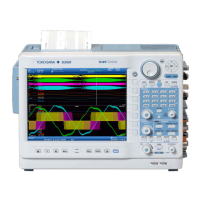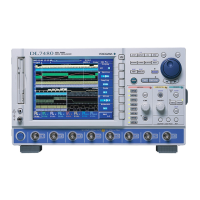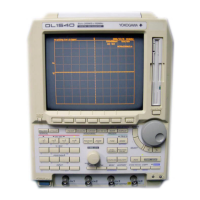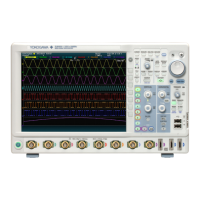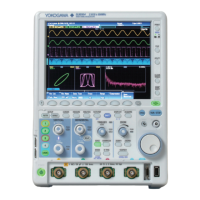2-13
IM DLM6054-01EN
Features
2
1
4
5
6
7
8
9
10
11
12
13
14
15
16
17
18
Index
App
section 6.3 for the procedure
Input coupling can be switched for the trigger source (not available with logic signals), just as with the
measured analog signals. Choose the input coupling that is appropriate for the trigger source.
There are two options available for input coupling with the trigger source:
• DC:
The DL6000/DLM6000 uses the trigger source as the trigger signal without processing it.
• AC: The DL6000/DLM6000 removes the DC component from the trigger signal.
section 6.3 for the procedure
Use HF rejection to remove high frequency components (above 15 kHz or 20 MHz) from the source
signal. This helps prevent high frequency noise from causing the DL6000/DLM6000 to trigger in
unexpected places (does not apply to logic signals).
section 6.3 for the procedure
When there is noise in the trigger source and no tolerance in the trigger level, the trigger point will
fluctuate each time the DL6000/DLM6000 triggers, and the displayed waveform will be unstable. Also,
when there is noise near the threshold, a slope whose polarity is opposite that of the set slope may
cause the DL6000/DLM6000 to trigger. To avoid these kinds of circumstances, you can set a range of
tolerance, the hysteresis, around the trigger level (not available with logic signals).
On the DL6000/DLM6000, you can set the hysteresis width to
(narrow) or (wide). When you
select
, a wide hysteresis range is set. This reduces false triggers and trigger offsets caused by
noise and results in a stable waveform display. However, this setting can decrease the accuracy of
trigger detection and make it more difficult for the DL6000/DLM6000 to trigger on sources with low
amplitudes. When dealing with stable waveforms that do not have noise or with waveforms with low
amplitudes, set the Hysteresis to
.
section 6.3 for the procedure
The window comparator qualifies conditions that are determined by a waveform’s rising/falling edge
or high/low state by whether or not they fall within a given range (Window IN/OUT). It qualifies trigger
conditions, qualifications, and state conditions.
You can enable or disable the window comparator separately for each channel. Adjusting the window
comparator on a channel that is set as the trigger source will alter the trigger condition.
For example, if you enable the window comparator on the source channel for an edge trigger, you can
only make the oscilloscope trigger within (Enter) or outside of (Exit) the set area.
2.3 Triggering

